Although it is best known for its use in Macintosh, Atari ST, and Amiga computers, the Motorola 68000 family of CPUs predates the Macintosh by five years.
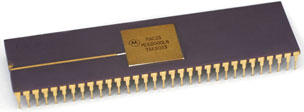 The 68000 CPU was designed as a higher power version of Motorola’s 6800 family, which is probably best known for the 6809E CPU used in Tandy Color Computers. The 6800 also inspired the 6502, designed by former Motorola engineers and used by Apple, Commodore, and Atari, among others.
The 68000 CPU was designed as a higher power version of Motorola’s 6800 family, which is probably best known for the 6809E CPU used in Tandy Color Computers. The 6800 also inspired the 6502, designed by former Motorola engineers and used by Apple, Commodore, and Atari, among others.
The original 6800 was an 8-bit CPU launched in 1974. It has a 16-bit address bus and can directly access 64 KB of memory. The 6800 was never popular in home computers, but the later 6809 (launched in 1978) was. In addition to the Tandy Color Computer, it was used by Acorn and in the Dragon 32/64.
A Big Step Forward
Motorola engineers worked on the 6809 and 68000 in parallel. The 6809 was intended to replace the 6800, while the 68000 was designed to be somewhat similar to the 6800 but be a full-fledged 32-bit CPU with a 16-bit data bus. It came to market in September 1979, just a year after the 6809.
Where the 6800 and 6809 came in 1 MHz and 2 MHz versions, the 6800 was initially available at 4, 6, and 8 MHz speeds. A 10 MHz version arrived in 1981, 12.5 MHz in mid 1982, and it reached 16.67 MHz in the late 1980s. That version was used at 16 MHz in the Mac Portable and PowerBook 100.
Although we’re more familiar with the 68000 for its use in personal computers, the chip is very well suited to Unix. The 68000 became a top choice for Unix-based machines and multi-user systems, including:
- Alpha Microsystems
- Apollo/Domain, circa 1980
- Corvus Concept, April 1982
- DEC VAXstation 100, May 1983
- Fortune 32:16, 1982
- HP 9000 series, 1984
- Sage II and IV, 1982
- Silicon Graphics 1000 and 1200, 1984
- Sun Microsystems Sun-1, May 1982
- Tandy TRS-80 Model 16, February 1982
680×0-based Personal Computers
1983
- Apple Lisa, January
1984
- Apple Macintosh, January
- Macintosh 512K “Fat Mac”, September
1985
- Atari 520ST, June
- Commodore Amiga 1000, July/August
1986
- Atari 1040STF, January?
- Macintosh Plus, January
- Macintosh 512Ke, March
1987
- Macintosh SE, March
- Macintosh II, March, first 68020 model
- Amiga 2000, March
- Amiga 500, April
1988
- Macintosh IIx, September, first 68030 model
1989
- Macintosh SE/30, January
- Macintosh IIcx, March
- Atari Stacy portable, September, first 68000-based portable
- Macintosh IIci, September
- Macintosh Portable, October
- Amiga 2500, November
1990
- Amiga 1500, March?
- Macintosh IIfx, March
- Amiga 3000, June
- Atari TT030
- Macintosh Classic, October
- Macintosh LC, October
- Macintosh IIsi, October
1983
Apple Lisa, January 1983
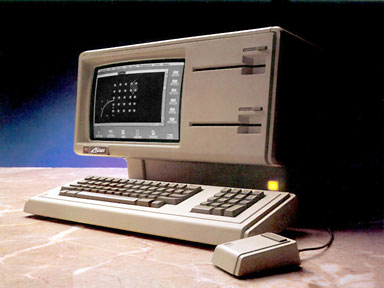 The first personal computer to ship with a 68000 CPU was the Apple Lisa, introduced on January 19, 1983. It introduced the mouse and graphical user interface to the public. Lisa ran its CPU at 5 MHz and included 1 MB of memory, which could be boosted to 2 MB. This was the era when an IBM PC could only be expanded to 640 KB, so that was a lot of memory.
The first personal computer to ship with a 68000 CPU was the Apple Lisa, introduced on January 19, 1983. It introduced the mouse and graphical user interface to the public. Lisa ran its CPU at 5 MHz and included 1 MB of memory, which could be boosted to 2 MB. This was the era when an IBM PC could only be expanded to 640 KB, so that was a lot of memory.
Apple used a new floppy drive known as Twiggy that could store 871 KB on a special 5.25″ floppy disk. Unfortunately, it proved to be troublesome. It was also compatible with the Apple ProFile hard drive, originally a 5 MB device and later upgraded with 10 MB of storage.
Lisa sold for $9,995, and only about 100,000 units were sold.
1984
Apple Macintosh, January 1984
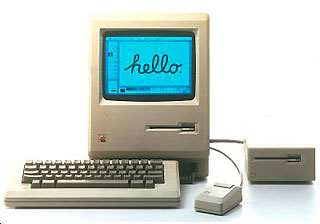 Announced to the world with Ridley Scott’s famous 1984 ad during Super Bowl XVIII, the Macintosh was vastly more affordable than Lisa at a retail price of $2,495. It was also less sophisticated and had a lot less memory.
Announced to the world with Ridley Scott’s famous 1984 ad during Super Bowl XVIII, the Macintosh was vastly more affordable than Lisa at a retail price of $2,495. It was also less sophisticated and had a lot less memory.
The original Mac had 128 KB of memory plus 64 KB of assembly language toolbox routines that programmers could access. Of that memory, 22 KB was used by the display, leaving just 106 KB for the operating system, software, and work files. (Because video used system memory, the CPU had limited access to RAM, reducing performance by about one-third.)
Unlike Lisa, there was no multitasking, no memory upgrade, and no hard drive option. Instead of a 12″ display, Macintosh had a 9″ screen.
On the plus side, its 68000 CPU ran at just under 8 MHz, the 3.5″ single-sided 400K floppy drive was reliable, and the Mac was a lot easier to tote from place to place. Apple even had a bag for that.
The most useful accessory was a second floppy drive, which connected to the back of the computer. This eliminated the floppy shuffle of having to swap the OS disk, application disk, and perhaps also a data disk as often the OS needed you to.
The Macintosh originally shipped with System 1.0, MacWrite 1.0, and MacPaint 1.0. Microsoft Word was a popular alternative to Apple’s free word processing app.
Macintosh 512K, September 1984
The biggest problem the original Mac had was too little system memory. With just 128 KB, there wasn’t room to do much. In fact, when Steve Jobs first demonstrated the Macintosh, it was a special version that had been upgraded to 512 KB. With the release of the Macintosh 512K (a.k.a. Fat Mac), the computer was unleashed.
The only real difference between the 512K and the 128K (the new name for the original Mac) was more memory and a higher price tag to cover the cost of higher capacity memory chips.
1985
Atari 520ST, June 1985
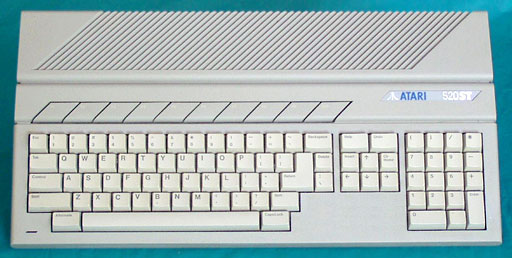 Apple didn’t introduce any new Macs in 1985, but Atari was ready to jump into the post-8-bit world with its own 68000-based computer. The new model was called the Atari 520ST, had an 8 MHz CPU, and included 512 KB of memory. (For those who want more, there are instructions online for taking the 520ST to 4 MB.)
Apple didn’t introduce any new Macs in 1985, but Atari was ready to jump into the post-8-bit world with its own 68000-based computer. The new model was called the Atari 520ST, had an 8 MHz CPU, and included 512 KB of memory. (For those who want more, there are instructions online for taking the 520ST to 4 MB.)
The 520ST was the first computer to ship with a built-in MIDI port, making it a favorite of musicians.
The computer had a new operating system known as TOS and used Digital Research GEM as its interface. It was the first color computer to have a graphical user interface – almost two years before the Macintosh II. A 520ST with a color monitor could display 320 x 200 graphics with 16 colors or 640 x 200 graphics with 4. The monochrome system had a resolution of 640 x 400 and cost $799 with a 360K 3.5″ external floppy drive – less than one-third the price of the Mac 512K. With a color display, the system sold for $999.
Atari also released the 260ST, essentially a 520ST with just 256 KB of memory. It was especially popular in Europe, where computers were more expensive than in the North American market.
Commodore Amiga 1000, July/August 1985
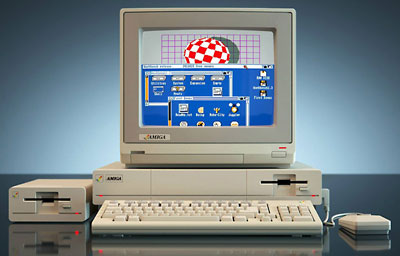 The third player in this market was Commodore, which had acquired Amiga in 1984. Amiga would be the first of the three companies to have an operating system with pre-emptive multitasking.
The third player in this market was Commodore, which had acquired Amiga in 1984. Amiga would be the first of the three companies to have an operating system with pre-emptive multitasking.
The Amiga 1000 (A1000) was the most advanced graphics and audio system on the market when it was introduced on July 23, 1985. It ran its 68000 CPU at 7.16 MHz but included additional chips to offload a lot of tasks handled by the CPU in Macs and Ataris. The A1000 was the first multimedia computer. It included composite video output for older monitors or recording to videotape.
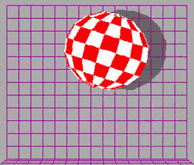 Nothing got people’s attention like the Amiga Boing Ball demo. It showed a red and white ball bouncing and spinning – and casting a shadow on a grid background. It did all this smoothly while other tasks were happening in the background.
Nothing got people’s attention like the Amiga Boing Ball demo. It showed a red and white ball bouncing and spinning – and casting a shadow on a grid background. It did all this smoothly while other tasks were happening in the background.
The A1000 shipped with just 256 KB of memory and could be upgraded to 512 KB. Later upgrades allowed taking it to 8.5 MB. Price with a color monitor was $1,595 – twice as much as the monochrome Atari ST and $1,200 less than the Fat Mac.
Commodore sold 35,000 Amigas in 1986. In March 1990, Commodore offered $1,000 for Amiga 1000 owners to trade up to the Amiga 2000.
1986
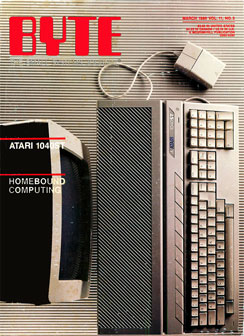 Atari 1040STF, 1986
Atari 1040STF, 1986
The Atari 520ST had some drawbacks: The external power brick was just one more item, and the external floppy drive was a nuisance when moving the system. The 1040STF has a built-in power supply and double-sided floppy drive. It was also the first personal computer to ship with 1 MB of RAM.
Macintosh Plus, January 1986
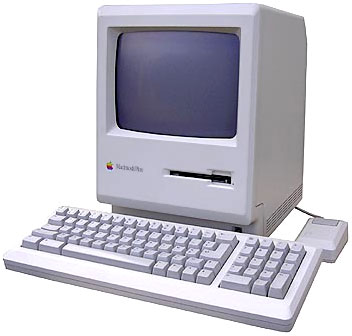 With the Macintosh Plus, Apple threw out some of the closed box thinking Steve Jobs had applied to the original design. Where the first two Macs had no fast hard drive bus, the Mac Plus introduced SCSI. Where the 128K and 512K were not designed for memory expansion, the 1 MB Plus could be upgraded to 4 MB using 30-pin SIMMs.
With the Macintosh Plus, Apple threw out some of the closed box thinking Steve Jobs had applied to the original design. Where the first two Macs had no fast hard drive bus, the Mac Plus introduced SCSI. Where the 128K and 512K were not designed for memory expansion, the 1 MB Plus could be upgraded to 4 MB using 30-pin SIMMs.
The Mac Plus was the first affordable personal computer to ship with 1 MB of RAM and the first to officially support an upgrade to 4 MB. With its SCSI port, you could easily attach hard drives, SyQuest drives, scanners, and SCSI printers.
New with the Mac Plus was an 800K double-sided 3.5″ floppy drive, and the Plus supported a new Hierarchical File System, which was especially useful on hard drives. Also new was a keyboard with a numeric keypad and arrow keys.
Macintosh 512Ke, April 1986
The Mac Plus had a double-sided floppy drive, but the 512K Fat Mac did not. Apple fixed this by replacing the 512K with the Mac 512Ke – for enhanced – in April 1986. The enhancements were an 800K floppy drive and the same ROMs as the Mac Plus, which were required to support the double-sided disk drive.
Unlike the Mac Plus, there is no SCSI port and no memory upgrade path.
1987
Macintosh SE, March 1987
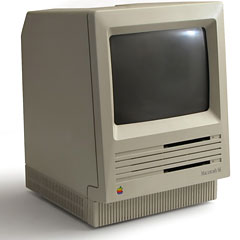
Introduced on March 2, 1987 along with the Macintosh II (below), the Macintosh SE was the first compact Mac design with a bay for an internal hard drive – or a second floppy drive. It also used an improved implementation of SCSI that made disk access about one-third faster than on the Mac Plus. Due to some improvements in ROM and on the logic board, the 8 MHz 68000 CPU in the SE benchmarks about 12% faster than in the Mac Plus.
The SE was the only compact 68000-based Mac with an expansion slot; it PDS (processor direct slot) could be used for ethernet, 8-color output, an AST Mac86 card, or an accelerator card. It was also the first compact Mac to use the Apple Desktop Bus (ADB) – introduced with the Apple IIGS in 1986 – for its mouse and keyboard.
For the first time, Macs shipped without a keyboard. Buyers of the SE and Mac II had the choice of a standard keyboard or Apple’s famed Extended Keyboard, which cost $100 more. At least the mouse was included with the computer.
The SE itself sold for $2,900 with two floppies, $3,900 with one floppy and a 20 MB hard drive – plus the cost of a keyboard.
Macintosh II, March 1987
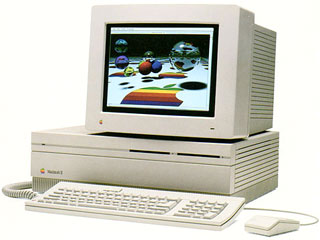 With the Mac II, Apple completely departed from the Jobsian notion that all expansion should be external. The Mac II has two floppy drive bays, a 5-1/4″ hard drive bay, and six NuBus expansion slots. There was no built-in video, so you had to use one slot for a video card – and Apple gave you lots of options: 1-bit black and white, 4-bit color (16 colors), and 8-bit color (256 colors) with a 16.7 million color palette, as seen in the photo on the right.
With the Mac II, Apple completely departed from the Jobsian notion that all expansion should be external. The Mac II has two floppy drive bays, a 5-1/4″ hard drive bay, and six NuBus expansion slots. There was no built-in video, so you had to use one slot for a video card – and Apple gave you lots of options: 1-bit black and white, 4-bit color (16 colors), and 8-bit color (256 colors) with a 16.7 million color palette, as seen in the photo on the right.
The Mac II has 32-bit Color QuickDraw in ROM; it supports any display size, any color depth, and multiple monitors, so you could conceivably have six displays connected to a single Mac II. The operating system even let you determine how the mouse would move from one screen to the next.
You could also install an AST Mac286 card to run MS-DOS. When 1.4 MB floppy drives became available, the Mac II would be able to read 3.5″ DOS disks. Until then, you needed an external 5-1/4″ floppy drive to work with PC discs.
The Mac II used the new 68020 CPU running at 16 MHz, which gives it about 3.5x as much power as the SE. Standard memory was 1 MB, with a promised maximum of 128 MB. Problem was, the industry made an unexpected change in higher density SIMMs, so the Mac II was limited to 8 MB unless you wanted to pay for more expensive, Mac-only memory. Then again, the 24-bit addressing in the Mac OS only supported 8 MB, so it wasn’t an issue until 32-bit addressing entered the picture with System 7.
The base Mac II with a 20 MB hard drive retailed for $5,500 plus keyboard, video card, and monitor. It was the first personal computer to use the 68020 CPU, which would only be used in one additional Mac.
Amiga 2000, March 1987
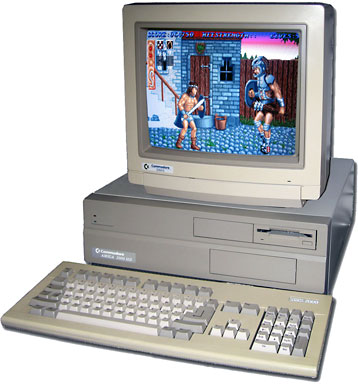 The Amiga 2000 (A2000) replaced the A1000 in March 1987. The A2000 case is taller to make room for two 3.5″ drive bays and one 5.25″ drive bay. The A2000 was the first Amiga to accept expansion cards without an add-on expansion chassis. It has five Zorro II card slots and four PC-style ISA slots – two 8-bit slots and two 16-bit slots. All this with a $1,500 price tag!
The Amiga 2000 (A2000) replaced the A1000 in March 1987. The A2000 case is taller to make room for two 3.5″ drive bays and one 5.25″ drive bay. The A2000 was the first Amiga to accept expansion cards without an add-on expansion chassis. It has five Zorro II card slots and four PC-style ISA slots – two 8-bit slots and two 16-bit slots. All this with a $1,500 price tag!
The A2000 shipped with 1 MB of memory and supports up to 9 MB. Its graphics were second only to the Macintosh II, which was much, much more expensive.
The Amiga 2000HD was an Amiga 2000 with an A2901 MFM hard drive controller and an MFM hard drive, usually 20 or 40 MB and typically a Seagate.
Amiga 500, April 1987
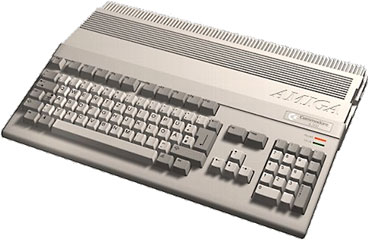 The Amiga 500 (A500) was Commodore’s first entry-level Amiga, intended to compete with the Atari 520ST. It had 512 MB of memory, ran its 68000 CPU at the same 7.16 MHz as the A1000 and A2000. It went on sale in the Netherlands in April 1987, the rest of Europe in May, and in the States in October, where it retailed at $699.
The Amiga 500 (A500) was Commodore’s first entry-level Amiga, intended to compete with the Atari 520ST. It had 512 MB of memory, ran its 68000 CPU at the same 7.16 MHz as the A1000 and A2000. It went on sale in the Netherlands in April 1987, the rest of Europe in May, and in the States in October, where it retailed at $699.
While the more expandable Amigas were sold only by computer dealers, the Amiga 500 was sold by mass market retailers – just like the Commodore 64 had been. The A500 became the most popular Amiga, selling 6 million units, and was widely viewed as a gaming computer, not just a machine for graphic hobbyists.
The Amiga 500 remained in the line until mid 1992, when it was replaced by the Amiga 600.
1988
Macintosh IIx, September 1988
There’s not a whole lot of difference between the Macintosh II and the IIx. Apple replaced the 16 MHz 68020 CPU with a 68030 CPU, giving the IIx built-in support for virtual memory. The Mac IIx was the first personal computer with a 68030 CPU.
Amiga A2286 Bridge Board, December 1988
The A2286 board contains an 8 MHz 80286 CPU, and the kit includes a 1.2 MB 5-1/4″ floppy drive, allowing Amiga 2000 to run IBM PC and AT software.
1989
Macintosh SE/30, January 1989
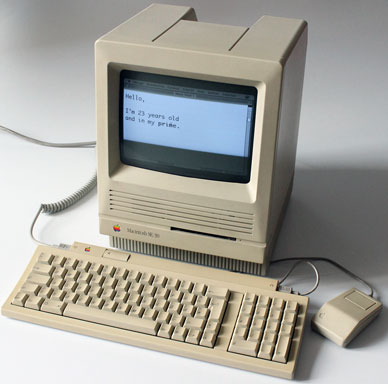 The Mac SE/30 is considered the high point of Apple’s black-and-white compact computers. It has the same 16 MHz 68030 CPU as the Mac IIx, a single PDS (processor direct slot) for upgrades, and a small footprint and 9″ display that made it a great choice as a server.
The Mac SE/30 is considered the high point of Apple’s black-and-white compact computers. It has the same 16 MHz 68030 CPU as the Mac IIx, a single PDS (processor direct slot) for upgrades, and a small footprint and 9″ display that made it a great choice as a server.
The SE/30 was the first compact Mac to ship with a 1.4 MB floppy drive, which could also read PC disks with special software. It was the last compact Mac with a floppy port for adding an external floppy drive.
The PDS allowed users to add an ethernet card, making the SE/30 a great server. Or they could add a Micron Xceed video card for 8-bit, 256-color output to an external monitor or 256 shades of gray on the internal display. Or for more power, there were lots of high-speed 68030 upgrades and 68040 upgrades.
The SE/30 had only one drawback: Its ROMs are not 32-bit clean, a problem it shares with the Mac II, IIx, and IIcx. You can run Mode32 on these Macs to patch the “dirty” ROMs.
Macintosh IIcx, March 1989
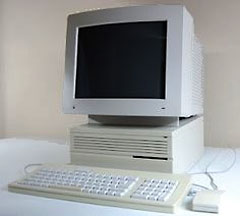 With the Macintosh IIcx, Apple introduced a new form factor – more expandable than the compact Macs but smaller and less expensive than the 18.7″ wide, 24 lb. Mac II and IIx. The IIcx (with c standing for compact) had only 3 NuBus expansion slots – 3 less than the IIx – and a smaller power supply but had the same level of power as the 16 MHz 68030-based Mac IIx. It was just 11.9″ wide and about 10 lb. lighter than the full-sized Mac II models. It could also be used on its side as a minitower.
With the Macintosh IIcx, Apple introduced a new form factor – more expandable than the compact Macs but smaller and less expensive than the 18.7″ wide, 24 lb. Mac II and IIx. The IIcx (with c standing for compact) had only 3 NuBus expansion slots – 3 less than the IIx – and a smaller power supply but had the same level of power as the 16 MHz 68030-based Mac IIx. It was just 11.9″ wide and about 10 lb. lighter than the full-sized Mac II models. It could also be used on its side as a minitower.
With prices starting at $5,369 with 1 MB of RAM, it was a lot less expensive than the base Mac IIx at $7,800. Of course with either you still need to add a video card, monitor, and keyboard, still making them expensive purchases. But the IIcx was more accessible – and 3 slots was enough for most users.
Amiga 2500
The Amiga 2500 is an Amiga 2000HD with a 14 MHz 68020 or 25 MHz 68030 CPU upgrade.
Atari Stacy, September 1989
 The Atari Stacy was the first portable 68000-based personal computer, beating the Macintosh Portable by a month. It was designed to run from 12 C cell batteries, but once Atari saw how quickly the batteries drained, it gave up on that idea.
The Atari Stacy was the first portable 68000-based personal computer, beating the Macintosh Portable by a month. It was designed to run from 12 C cell batteries, but once Atari saw how quickly the batteries drained, it gave up on that idea.
Stacy has an 8 MHz 68HC000 CPU, a lower power version of the 68000. It came in 1 MB, 2 MB, and 4 MB versions and supports a maximum of 4 MB.
The display uses a backlit 10.4″ 640 x 400 passive matrix grayscale Epson screen and can also display 640 x 200 4-shade and 320 x 200 16-shade graphics.
Stacy weighed 15.2 lb. and retailed for $2,299 in a 1 MB floppy-only configuration – an absolute steal in comparison to the Mac Portable (below). Like the Mac Portable, it was available with a low-power Connor hard drive, either 20 MB or 40 MB.
The Atari Stacy was especially popular with musicians, as it was the only portable with built-in MIDI ports at the time. It was far easier to transport a Stacy than any other Atari ST model plus a CRT display (LCD monitors were still in the future outside of laptops).
Stacy may have been the first portable to market with a built-in trackball, and it was one of the earliest with a numeric keypad, although the keypad used smaller keys than the main keyboard.
Macintosh IIci, September 1989
 The Mac IIcx was a hit, and six months later Apple took a big step forward with the first Mac faster than 16 MHz. The Mac IIci used a 25 MHz 68030 CPU and was the first Mac with 32-bit clean ROMs, allowing it to support 128 MB of memory without special software.
The Mac IIcx was a hit, and six months later Apple took a big step forward with the first Mac faster than 16 MHz. The Mac IIci used a 25 MHz 68030 CPU and was the first Mac with 32-bit clean ROMs, allowing it to support 128 MB of memory without special software.
Although it retailed for $6,269, it wasn’t really any more expensive than the IIcx, since it had built-in video that didn’t require using a NuBus video card to tie up one of its three expansion slots.
The IIci was the first Mac to use the burst memory access mode of the 68030 CPU, which boosted performance by 10%. This helps offset the fact that the built-in video uses system memory, which reduces performance by about 8%. You can get that speed back by using a NuBus video card, but with the IIci you got to make that choice – save some money and lose 8% of your power or spend money on a video card the maximum performance.
To further boost performance, Apple sold a 32 KB level 2 cache card that would boost performance by 15% or more, and third-party cache cards with bigger caches improved things even more. This is because while the memory bus ran at 25 MHz, the 80ns memory can’t keep up and must insert two (and sometimes three) wait states between accesses. This is one more than 16 MHz models, so in essence they are all accessing system memory at 8.0 to 8.33 MHz – and that level 2 cache runs flat out on a 25 MHz bus.
There were also third-party accelerator cards with faster 68030 CPUs or newer, more efficient 68040 chips. The IIci was one of the most flexible Macs ever in terms of upgrades. It remained in the Macintosh line for 3-1/2 years, one of the longest-lived models ever.
Macintosh Portable, October 1989
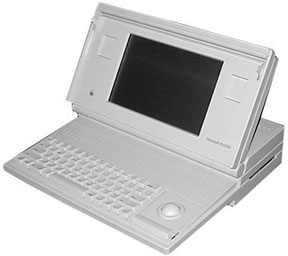 Apple’s first portable was the 16 MHz Macintosh Portable, a 16 lb. beast of a machine that retailed for $6,500 with just a floppy drive and $7,300 with a custom low-power 40 MB Connor CP-3045 hard drive. At least it has a handle on the front to facilitate transport.
Apple’s first portable was the 16 MHz Macintosh Portable, a 16 lb. beast of a machine that retailed for $6,500 with just a floppy drive and $7,300 with a custom low-power 40 MB Connor CP-3045 hard drive. At least it has a handle on the front to facilitate transport.
It uses a 16 MHz 68000 CPU, making it over twice as fast as the Macintosh SE (see our review of the Brainstorm accelerator for an explanation of why it can more than double performance) and faster than Atari’s 8 MHz Stacy.
Users could choose to use either a trackball or a full-size numeric keypad with the main keyboard, and it could be located on the left or right side, which had to make lefties rejoice. There is also an ADB port in the back for use with a mouse or external keyboard.
The huge Mac Portable had an even smaller screen than the Atari Stacy, and it wasn’t even backlit. It did have the same 640 x 400 resolution but no support for grayscale.
To reduce power draw, the Mac Portable uses expensive static memory (SRAM), which retains data even when the computer is powered down for instant startup exactly where you left off. The Portable has a 5W 13 amp sealed lead-acid battery – the same technology found in car and motorcycle batteries – and will not function without a battery that is holding a charge.
In February 1981, Apple introduced a backlit version of the Mac Portable.
1990
Amiga 1500
The Amiga 1500 was a UK-only model aimed at the lower end of the market. In reality, the A1500 was an A2000 with two 3.5″ floppy drives and no hard drive, which helped get the price down to £999 (VAT included). The A1500 sold very well, and there was an option to add a hard drive, which would make it fully equivalent to the A2000.
Macintosh IIfx, March 1990
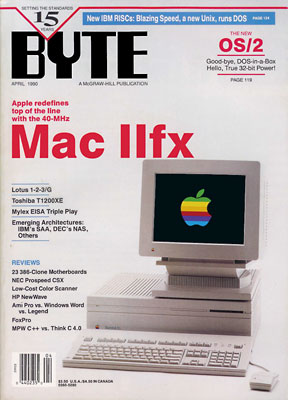 There were times when Apple really pushed the envelope, and the 40 MHz Macintosh IIfx was one of them. At the time, the 25 MHz Mac IIci was the fastest Mac, and the fastest PCs were 33 MHz 80386 machines. A 32 KB level 2 cache running at 40 MHz is standard, and Apple claimed that 96% of memory access is done using the cache with zero wait states. The RAM itself is 80ns DRAM, just like in the 16 MHz and 25 MHz Macs. One would presume the IIfx inserts 4 wait states when accessing memory on the logic board.
There were times when Apple really pushed the envelope, and the 40 MHz Macintosh IIfx was one of them. At the time, the 25 MHz Mac IIci was the fastest Mac, and the fastest PCs were 33 MHz 80386 machines. A 32 KB level 2 cache running at 40 MHz is standard, and Apple claimed that 96% of memory access is done using the cache with zero wait states. The RAM itself is 80ns DRAM, just like in the 16 MHz and 25 MHz Macs. One would presume the IIfx inserts 4 wait states when accessing memory on the logic board.
Unlike earlier Macs, the IIfx uses coprocessors, a lesson Apple may have learned from the Amiga. One is a DMA controller to handle the SCSI bus, offloading that from the CPU. There are also two 10 MHz 6502 chips used to handle the ADB bus and floppy drives, again freeing the 40 MHz 68030 to run as fast as it can. BYTE magazine says the IIfx is 60% faster overall than the 25 MHz IIci (April 1990, p. 112).
One more performance boost comes from the 24-bit 8•24 GC, Apple’s first accelerated video card.
The IIfx is the only full-sized Mac II model with a PDS (processor direct slot), but using it disables one of the six NuBus slots.
All of this power didn’t come cheap. A base Mac IIfx would set you back $10,000 – plus a video card, display, keyboard, and probably more memory and a faster, larger hard drive as well. This was definitely the high point of the Macintosh II family.
Amiga 3000, June 1990
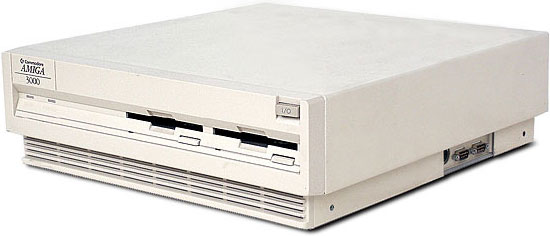 The Amiga 3000 was the first Amiga designed from the ground up as a 32-bit machine using the Motorola 68030 CPU. It was intended as a high-end workstation and retailed at $3,495. The base model had a 16 MHz CPU and 2 MB of memory; the top-end version used a 25 MHz 68030. It shipped with AmigaOS 2, which was more visually attractive than earlier versions.
The Amiga 3000 was the first Amiga designed from the ground up as a 32-bit machine using the Motorola 68030 CPU. It was intended as a high-end workstation and retailed at $3,495. The base model had a 16 MHz CPU and 2 MB of memory; the top-end version used a 25 MHz 68030. It shipped with AmigaOS 2, which was more visually attractive than earlier versions.
Like the Mac IIfx, the A3000 supports DMA access of the SCSI II bus, freeing the CPU from that task. It was compatible with most Amiga peripherals, but internally it had four 32-bit Zorro III expansion slots rather than the 16-bit Zorro II slots of the A2000.
Commodore chose to use ZIP memory chips in the A3000, a direction the rest of the industry did not follow, making it costly and difficult to find memory upgrades. The A3000 supports up to 2 MB of chip RAM, 16 MB of “fast” RAM, 128 MB on a CPU card, and up to 2 GB using Zorro III expansion cards.
The A3000 has improved support for VGA monitors via its “display enhancer” technology. Variants include the A3000UX, which shipped with AT&T Unix System V Release 4, and the A3000T, a tower version of the A3000.
Commodore was developing an A3000+ with the AT&T DSP 3210 signal processing chip and reached prototype stage before nixing it. The DSP 3210 ended up in the Macintosh Centris 660AV and Quadra 840AV, released in July 1993.
Atari TT030, 1990
Atari realized that the 68000 chip was falling behind and designed the TT030 as a true 32-bit computer with a 32-bit data bus. To give it a perceived edge against the 16-25 MHz competition, the TT030 used a 32 MHz 68030 CPU, although it was somewhat crippled by running on a 16 MHz data bus. (See our article on the Macintosh Performa 600 and Mac IIvx to learn more about how much that can compromise performance.)
The TT030 adopted some industry standards: VGA monitor support, an AppleTalk network port (for which there were no drivers). a true SCSI ports (not Atari’s ddd), and VMEbus for expansion.
The TT030 shipped with TOS 3.01, which still didn’t have pre-emptive multitasking. A Unix version, the TT/X, shipped in mid 1992 with Unix System V Release 4.
The base TT030 shipped with 2 MB of memory (16 MB maximum), a 50 MB hard drive, and a 720 KB 3.5″ floppy drive. It was originally sold in Germany and came to the US in 1991, where it sold for $2,995. Later versions included a 1.44 MB high-density drive.
Macintosh Classic, October 1990
 Going to the opposite end of the spectrum, Apple introduced the Mac Classic in October 1990. It replaced the Mac Plus, which was on the market from January 1986 to October 1990, and the Mac SE, introduced in March 1987 and also discontinued in October 1990. Like them, the Mac Classic was a black-and-white compact Mac with a 9″ display and an 8 MHz 68000 CPU.
Going to the opposite end of the spectrum, Apple introduced the Mac Classic in October 1990. It replaced the Mac Plus, which was on the market from January 1986 to October 1990, and the Mac SE, introduced in March 1987 and also discontinued in October 1990. Like them, the Mac Classic was a black-and-white compact Mac with a 9″ display and an 8 MHz 68000 CPU.
On the plus side, the 1 MB Mac Classic with no hard drive retailed for $999, the lowest price to date for a Macintosh. It was the only Mac ever to have Mac OS system software in ROM – by holding down Cmd-Opt-X-O at startup, the Classic would boot System 6.0.3.
On the minus side, the base model did not include the 1 MB memory expansion card necessary for upgrading to 4 MB total memory. Where the Plus and SE had SIMM slots on the system board, the Classic did not. It required a card that fit a special slot on the system board, and that card had 1 MB of memory and two SIMM slots for adding two 1 MB SIMMs.
The $1,499 hard drive model included that card, 2 MB of memory, and a 40 MB hard drive. Unlike the SE, the Classic has no expansion slot.
Macintosh LC, October 1990
Where the Mac Classic repackaged an existing design, the Macintosh LC was an entirely new machine aimed at the low end of the color market. The LC shipped with 2 MB of memory, a 40 MB hard drive, and a 16 MHz 68020 CPU – the same one used in the Mac II back in 1987. Like the Mac IIci, the LC has built-in video support. Best of all, the low-cost machine even includes an expansion slot, the LC PDS (processor direct slot), which would be used in numerous ways.
Wanting to get Mac into schools, Apple designed the Apple IIe Card for the LC PDS, along with a 12″ color monitor with 512 x 384 resolution. Combined with an external 5-1/4″ floppy drive, the LC with an Apple II card was nearly 100% compatible with existing Apple II software, which many schools had been using for years. It also gave the Macintosh platform a foot in the door at Apple II-only institutions.
The LC had two built-in limitations. It used a 16-bit data bus with a 32-bit CPU, which crippled performance, and it topped out at 10 MB of memory – far less than any Mac II series machine. A third limitation is that the 68020 CPU doesn’t support virtual memory, but that wasn’t really an issue in 1990.
Regardless of some compromises, it was a hit. With a color display, it would easily cost $3,000, but it was showing up beneath Christmas trees during the 1990 holiday season.
Macintosh IIsi, October 1990
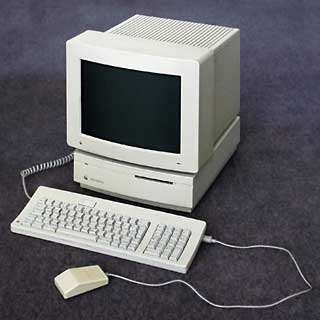 The third model introduced in October 1990 was the Macintosh IIsi, a smaller version of the Mac IIci with a PDS but no built-in NuBus slot. It was the only model in the Mac II series without a built-in NuBus slot.
The third model introduced in October 1990 was the Macintosh IIsi, a smaller version of the Mac IIci with a PDS but no built-in NuBus slot. It was the only model in the Mac II series without a built-in NuBus slot.
In many ways, the IIsi was deliberately compromised to prevent it from taking too many sales away from the Mac IIci. It could have run at 25 MHz and many have been overclocked to 28 MHz, but Apple set its speed at 20 MHz to keep it from competing with the 25 MHz IIci.
Then again, it was three steps ahead of the Mac LC: It used a 68030 CPU and thus supported virtual memory, it had a full 32-bit memory bus, and it supports up to 65 MB of memory. This became a very popular word processing machine when combined with the Apple’s Portrait Display or a Radius Full Page Display.
Continued in Timeline of 680×0 Computers, 1991-1996.
Keywords: #amiga #atarist #macintosh
Short link: http://goo.gl/QMzJgi
searchword: 68ktimeline

